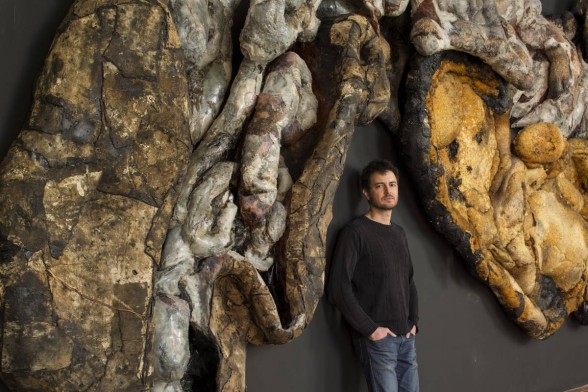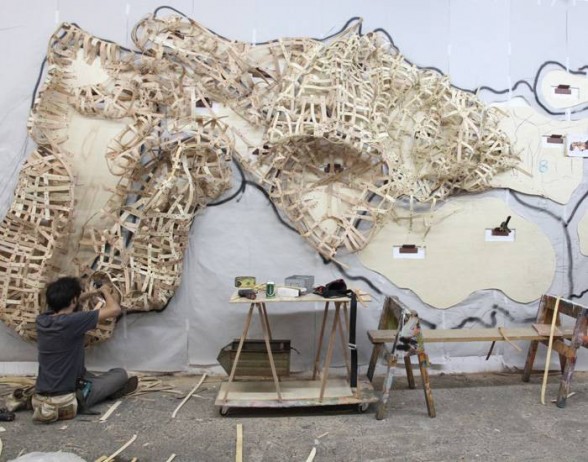[Natalia offers an insightful take on a larger-than-life sculptural installation inspired by humanity’s less admirable habits–and the health consequences we often face as a result. — the Artblog editors]
Currently on view at the Arthur Ross Gallery of the University of Pennsylvania is a large-scale installation by contemporary Brazilian artist Henrique Oliveira. This monumental piece enacts a social critique of environmental destruction, human consumption, and societal decay, using bodily disease as a powerful metaphor.
A broad critique of consumption

The site-specific installation, titled Poliresidual Adenocalcinoma, consists of a single piece–a monstrous creation of twisted plywood and cardboard, covered with a layer of charred sheets of metal, plastic, asphalt, fiberglass, and foam that Oliveira has compared to human skin. Commissioned by the gallery and curated by associate director Dejáy B. Duckett, the work marks the internationally-renowned artist’s first exhibition in Philadelphia.
Upon visiting Arthur Ross Gallery, the artist remarked that its architectural style reminded him of a natural history museum. Indeed, his grotesque construction resembles the fossilized intestinal track of a great beast, its contortions illuminated for public display by the light that streams from the Gothic windows along the far side of the gallery.
In conceiving Poliresidual Adenocalcinoma, Oliveira began with a microscopic image of a carcinogenic cell, taken from a medical textbook. By using materials such as plastic and asphalt to recreate the cell in monumental proportions, Oliveira aimed to create a “correspondence” between cancers of the human body and the ceaseless consumption of petroleum products by mankind, a metaphorical cancer upon the earth. Accordingly, Adenocalcinoma, a neologism of Oliveira’s invention, derives from “adenocarcinoma,” a type of cancerous tumor that occurs throughout the body, as well as “calcination,” a reference to the burning process applied in the creation of the object. Poliresidual refers to the refuse nature of the found materials incorporated.

With Poliresidual Adenocalcinoma, Oliveira contributes to a long tradition of socially engaged art-making in modern Brazil. As early as the 1960s, artists like Lygia Clark and Hélio Oiticica drew inspiration from the sprawling favelas of Rio de Janeiro, incorporating elements of makeshift architecture into their work. In a similar fashion, Oliveira gathered his materials for Poliresidual Adenocalcinoma from dumpsters around São Paulo, embedding the work with a critique of human consumption and wastefulness through his use of materials.
Such issues have been on the forefront of Brazilian consciousness in 2014. The extravagant spectacle of the FIFA World Cup this past summer left many citizens questioning if resources would have been better invested in public services like healthcare, infrastructure, and education. Similarly, in November, the BBC reported that Brazil’s rate of deforestation rose by 28%, the result of controversial reforms to environmental protection laws.
By recycling discarded materials and transforming them into a larger-than-life rendition of a cancerous cell, Oliveira encourages his audience to think critically with regard to these “environmental aggressions”. Additionally, Poliresidual Adenocalcinoma’s placement on the wall of the gallery space references traditional art-making practices, perhaps enacting further criticism of public consumption vis-à-vis the commodification of the art object. With Poliresidual Adenocalcinoma, Oliveira creates a multiplicity of correspondences between questions of human progress and resource depletion, social awareness and societal decay. The installation will be on display until Jan. 15, 2015.
Polyresidual Adenocalcinoma is on view at Arthur Ross Gallery, 220 S. 34th St., from Oct. 16, 2014 to Jan. 15, 2015.









